All posts by Andrea Grant
About Andrea Grant
Andrea Grant is a Children's Services Specialist. View all posts by Andrea Grant →
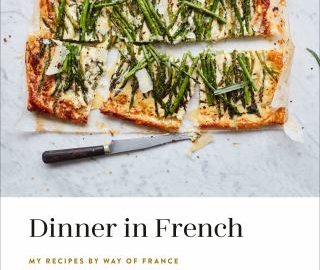
Bibliobites in May: Comme Ci, Comme Ça
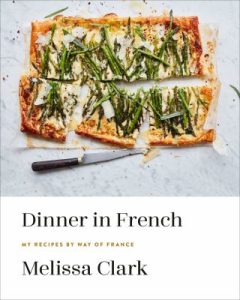 What is it about French food that perpetually fascinates? Is it that European cultural savoir-faire, or the elegance we typically associate with France? Is it the food itself: not too challenging for most palates, often rich with butter and cheese; and accented with wine and herbs like tarragon or chives? Is it the vibrant personalities associated with some of its proponents, like Julia Child and Jacques Pépin? Perhaps all of the above? Whatever the lure, since Julia Child published Mastering the Art of French Cooking in the early 1960s, there’s been a near constant parade of French cookbooks. Though Americans have often been derided for their love of quick and easy cooking (and their dependence on takeout), this enduring appeal of classic French cuisine tells a somewhat different story. This month our Bibliobites group took on la cuisine française with NY Times writer and author Melissa Clark’s latest, Dinner in French.
What is it about French food that perpetually fascinates? Is it that European cultural savoir-faire, or the elegance we typically associate with France? Is it the food itself: not too challenging for most palates, often rich with butter and cheese; and accented with wine and herbs like tarragon or chives? Is it the vibrant personalities associated with some of its proponents, like Julia Child and Jacques Pépin? Perhaps all of the above? Whatever the lure, since Julia Child published Mastering the Art of French Cooking in the early 1960s, there’s been a near constant parade of French cookbooks. Though Americans have often been derided for their love of quick and easy cooking (and their dependence on takeout), this enduring appeal of classic French cuisine tells a somewhat different story. This month our Bibliobites group took on la cuisine française with NY Times writer and author Melissa Clark’s latest, Dinner in French.
Though Ms. Clark states in her introduction that her food is a merging of France and Brooklyn, there’s a lot more of the former than the latter. There are twists on many iconic French dishes, but overall they are pretty firmly rooted in tradition. Interestingly, despite the general fascination with French food, most in our group aren’t all that familiar with it, nor have we made many classic French dishes. As always, the way out of ignorance is knowledge, so how did it go in the kitchen?
As you might expect from a French cookbook, there’s a chapter devoted to eggs, and one to cheese. Three people were intrigued by 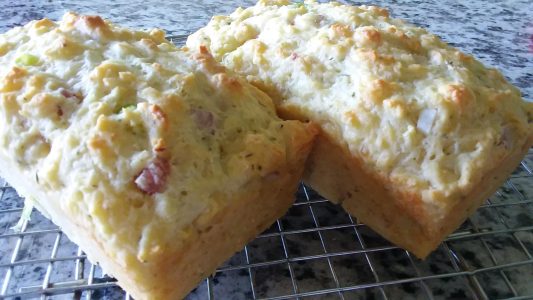 savory gruyère bread with ham. This loaf made an excellent, cheesy snack or hors d’oeuvre, and it was also “great with a fried egg on top.” The recipe came together easily, and it also freezes well. The idea of a savory loaf was new to many of us, but it’s a keeper! Twice-baked cheese soufflés were a riff on the classic; with its multiple components it took “a lot of time.” However it was tasty, “….not super-light, more like a cross between a souffle and a quiche.” And speaking of the iconic quiche, sweet potato and bacon quiche with parsley turned out to be a good combination that “grew on me.” It aged nicely, too.
savory gruyère bread with ham. This loaf made an excellent, cheesy snack or hors d’oeuvre, and it was also “great with a fried egg on top.” The recipe came together easily, and it also freezes well. The idea of a savory loaf was new to many of us, but it’s a keeper! Twice-baked cheese soufflés were a riff on the classic; with its multiple components it took “a lot of time.” However it was tasty, “….not super-light, more like a cross between a souffle and a quiche.” And speaking of the iconic quiche, sweet potato and bacon quiche with parsley turned out to be a good combination that “grew on me.” It aged nicely, too.
Vegetables and salads went to France, as well: classic salade niçoise was delicious despite our cook’s avoidance of the called-for olives and anchovies, “I did like it!” Shaved zucchini and melon salad with mint and almonds was an easy and refreshing accompaniment to many main dishes; but asparagus almondine was “too much work for asparagus!” We made a couple of heartier veggies, too: 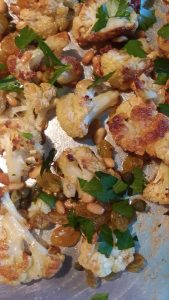 roasted cauliflower with brown butter, raisins, and capers was a lovely combination with its raisins and capers. The brown butter added rich, savory notes. Sautéed cabbage with gruyère and jalapenos was a meal in itself, with hearty browned cabbage and plenty of cheese on top. The jalapenos added welcome heat.
roasted cauliflower with brown butter, raisins, and capers was a lovely combination with its raisins and capers. The brown butter added rich, savory notes. Sautéed cabbage with gruyère and jalapenos was a meal in itself, with hearty browned cabbage and plenty of cheese on top. The jalapenos added welcome heat.
Main dishes were of course on tap: roasted tarragon chicken with crispy mushrooms was “really good” with “nice tarragon flavor.” Our cook added some potatoes to the roasting pan for a more complete, mostly hands-off meal. Two people tried beef daube with carrots and honey vinegar; depending on who made it, it was either “moist” or “too dry!” With a full bottle of red wine as the liquid, it had “a lot of flavor” and was “intense– very rich.” It might be too much of everything; it was “not a keeper.” But, roasted tarragon shrimp and onions was definitely a keeper, “…my favorite! Absolutely delicious!” Hake with herb butter en papillote was another good choice; with copious amounts of butter it was “very rich.” The fish and spinach stayed moist and tender inside their parchment packets. Almost-vegetarian lentil stew with garlic sausage and goat cheese was comforting and hearty with its salty, garlicky notes. Though it certainly wouldn’t win any prizes in the looks department (notably, there was no photo of the finished dish), it was a tasty stew that improved in the fridge. A keeper! Pissaladière with tomato, olives, and anchovies was another mostly vegetarian hit. This Provençal take on pizza features caramelized onions which provided rich, savory flavor. The yeast dough was enriched with olive oil, which made it easy to work with. It was a bit of a production to make all the components, but “we really liked it;” even better, “it looked just like the photo!”
Despite several successes, on the whole, this title wasn’t a huge hit. A couple of people thought the recipes involved way too much work for a weeknight; and we questioned whether most people would really want to dive into them on your average Tuesday night. And much of what we tried contained fair amounts of butter and/or cheese– something you might not want in your regular weeknight rotation. We also thought it interesting that (in a “family dinner” book) many of the recipes were scaled for 6-8 servings rather than 4-6, though it was true that most made excellent leftovers. We did appreciate that the author gave detailed instructions on how to prep or make ahead either a whole dish or some of its components. Though Ms. Clark clearly loves France and French food, she failed to win any converts within our group (well, maybe one person!). As a result, our voting averaged out to a not-very-impressive 2.25 out of a possible 5. C’est la vie!
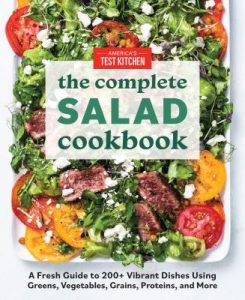
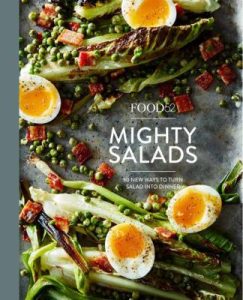 Our next meeting will be on Friday, June 24 at 11 AM. We’ll meet in hybrid format; please register for either in-person or remote attendance. Since warmer days are here, we’ll be cooking (assembling?) our way through two summery titles: The Complete Salad Cookbook from America’s Test Kitchen, and Food52 Mighty Salads by the editors of Food52. Choose one or both; copies are available at the main circulation desk or via curbside pickup. See you on the 24th!
Our next meeting will be on Friday, June 24 at 11 AM. We’ll meet in hybrid format; please register for either in-person or remote attendance. Since warmer days are here, we’ll be cooking (assembling?) our way through two summery titles: The Complete Salad Cookbook from America’s Test Kitchen, and Food52 Mighty Salads by the editors of Food52. Choose one or both; copies are available at the main circulation desk or via curbside pickup. See you on the 24th!
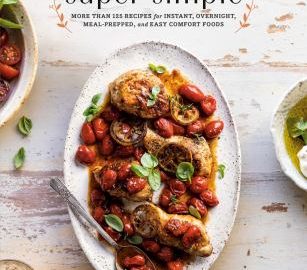
Bibliobites in April: Simply Super
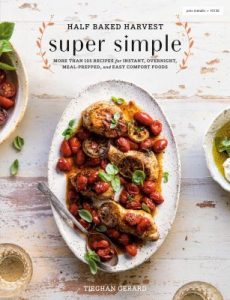 In the world of cookbooks, the quest for the perfect dinner seemingly never ends. Legions of chefs and bloggers continue to produce books promising us a flavorful, foolproof, from-scratch meal without spending hours in the kitchen. This month our Bibliobites group returned to this well-worn path with Half Baked Harvest Super Simple by popular blogger and Instagrammer Tieghan Gerard. Did we feel the love? And more precisely, were the recipes worthy of our time and taste buds?
In the world of cookbooks, the quest for the perfect dinner seemingly never ends. Legions of chefs and bloggers continue to produce books promising us a flavorful, foolproof, from-scratch meal without spending hours in the kitchen. This month our Bibliobites group returned to this well-worn path with Half Baked Harvest Super Simple by popular blogger and Instagrammer Tieghan Gerard. Did we feel the love? And more precisely, were the recipes worthy of our time and taste buds?
Ms. Gerard’s first claim to fame was as a food photographer, and the photos in this book did not disappoint. There are inviting, full-page photos of almost every recipe, a feature we always appreciate. The font is a bit smaller than we might have liked, but as a result, many, if not most, recipes fit on one page– helpful for cooks with messy hands! One person noted that this book is available with a spiral binding, super-practical if not quite as sturdy as a regular library binding. We also liked that the recipes often provided options for method; for instance, you could make a soup either on the stove, in the slow cooker, or in a multicooker (Instant Pot). When we got down to the actual cooking, one person spoke for all when she commented that the food was “easy yet amazing.” So, spoiler alert: this book is one of our highest rated ever!
With all that amazing food, you might think we thoroughly tested plenty of recipes– and you would be right. Though this book includes chapters on breakfast, appetizers, and desserts, as usual most of us focused on main dishes. 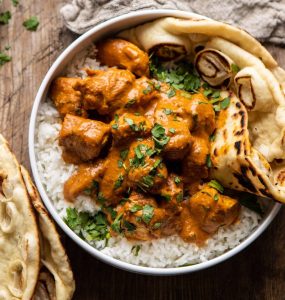 For all you carnivores out there, among the hits were “very tender” coconut chicken tikka masala; though, with 3 tablespoons of garam masala, “make sure you like your brand,” as it’s the dominant flavor. Staying with chicken, instant chicken gumbo was “spicy….really good,” and it aged well. Kai’s favorite sesame orange chicken was indeed a favorite. It had a yummy soy- and hoisin-based sauce and tasted “awesome.” Three people made white wine braised chicken with artichokes and orzo; everyone loved the combination of artichokes and olives; lemon added “a nice zing.” Also, “leftovers are really good– if you have any!”
For all you carnivores out there, among the hits were “very tender” coconut chicken tikka masala; though, with 3 tablespoons of garam masala, “make sure you like your brand,” as it’s the dominant flavor. Staying with chicken, instant chicken gumbo was “spicy….really good,” and it aged well. Kai’s favorite sesame orange chicken was indeed a favorite. It had a yummy soy- and hoisin-based sauce and tasted “awesome.” Three people made white wine braised chicken with artichokes and orzo; everyone loved the combination of artichokes and olives; lemon added “a nice zing.” Also, “leftovers are really good– if you have any!”
There were other meaty doings, as well: three cooks chose to make quick Filipino adobo, a pork stew with a lively salty, tart, and fruity marinade. 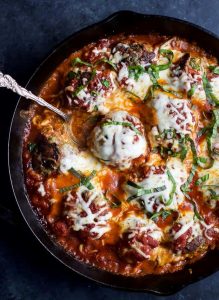 Sun-dried tomato and turkey meatball bake was just plain “wicked good;” as an added bonus, it only dirtied one pan. Gingered apple pork chops sounded luscious, but called for too much cumin, which overpowered the other flavors. But, “I would try it again.”
Sun-dried tomato and turkey meatball bake was just plain “wicked good;” as an added bonus, it only dirtied one pan. Gingered apple pork chops sounded luscious, but called for too much cumin, which overpowered the other flavors. But, “I would try it again.”
Moving on to fishy territory, browned butter scallops were “quick and easy,” and tasty, too. But sesame crusted salmon was a bit of a flop– it was “bland” despite the sesame crust, and “sounded better than it was.” Extra saucy coconut fish curry was so good, our cook made it twice! The lime and other Thai flavors hit the spot, and, combined with coconut milk, it was all “yum!” One pot Spanish chorizo, shrimp, and rice pilaf was another dish that was easy and loaded with flavor; spicy chorizo and smoked paprika beautifully complemented the shrimp. Unfortunately, another shrimp dish, jalapeno garlic butter shrimp, didn’t make the grade– somehow the flavors of garlic and honey didn’t come through.
This title doesn’t neglect vegetarians, either: there were plenty of options to choose from. Three people made spinach and artichoke macaroni and cheese bake. For some it was a keeper, “the best ever;” and it had the undeniable virtue of being a one-pot recipe. But one person felt it somehow didn’t taste cheesy, despite using sharp cheddar. The addition of spinach and artichokes was definitely welcome, though. We tried a few other noodle-based dishes: penne alla vodka two ways was easy enough, though it was “a bit too spicy…good but not great.” Four people made 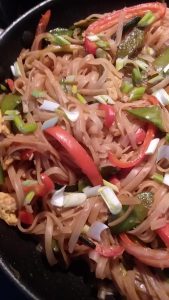 veggie loaded pad see ew, a cousin of pad Thai. For one person it was a keeper; others thought it was a solid, if not outstanding, choice, with a sauce that was either “really good” or “needed something!” We did like being able to customize the amounts and types of veggies to suit our mood and what we had on hand. It was hard to argue with garlic butter ramen (because how can you go wrong with garlic and butter together?); it was tasty and “so easy!” However, it was “a lot of butter,” a flaw or a plus, depending on how you want to look at it. Mushroom “cheese-steaks” were so fantastic that “I made them three times!” These were very easy and quick to make, and were an excellent leftover. However the accompanying yum yum sauce was “disappointing– it needed something;” but it was still “my all-time favorite!”
veggie loaded pad see ew, a cousin of pad Thai. For one person it was a keeper; others thought it was a solid, if not outstanding, choice, with a sauce that was either “really good” or “needed something!” We did like being able to customize the amounts and types of veggies to suit our mood and what we had on hand. It was hard to argue with garlic butter ramen (because how can you go wrong with garlic and butter together?); it was tasty and “so easy!” However, it was “a lot of butter,” a flaw or a plus, depending on how you want to look at it. Mushroom “cheese-steaks” were so fantastic that “I made them three times!” These were very easy and quick to make, and were an excellent leftover. However the accompanying yum yum sauce was “disappointing– it needed something;” but it was still “my all-time favorite!”
Since our weather in April was on the cool side, we were still making soup: chicken tortilla soup was a “super easy” keeper, with garnishes (crushed tortilla chips, diced mango and avocado) that kicked it up a notch. Golden butternut squash soup was rich and creamy with coconut milk and savory with shallots, an easy and delicious version of this now-classic soup. Another classic, broccoli cheddar soup, wasn’t quite cheesy enough, but all was forgiven since the topper of seasoned pretzels was addictive– “really good!” A couple of veggie sides were also standouts: 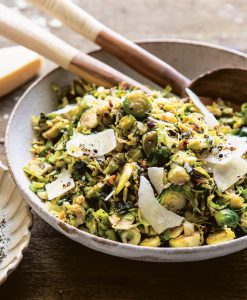 cacio e pepe brussels sprouts were fantastic, with loads of pepper and Parmesan cheese delivering big-time flavor. Black pepper buffalo cauliflower bites were “a bit of work” since you had to coat all the flowerets with a sauce and then breadcrumbs mixed with Parmesan, but they were an appealing way to eat cauliflower. However, the ranch dressing had “too much dill,” though that could easily be adjusted.
cacio e pepe brussels sprouts were fantastic, with loads of pepper and Parmesan cheese delivering big-time flavor. Black pepper buffalo cauliflower bites were “a bit of work” since you had to coat all the flowerets with a sauce and then breadcrumbs mixed with Parmesan, but they were an appealing way to eat cauliflower. However, the ranch dressing had “too much dill,” though that could easily be adjusted.
There aren’t a ton of desserts in this book, and oddly enough not many of them called to us. One person tried the chocolate mousse and thought it was “eh!” The cream cheese in it was hard to incorporate (even when it was at room temp) and left visually unappealing little white blobs in the finished mousse; also, it possibly “needed more sugar?” All in all, not a winner. Two people baked the intriguingly named 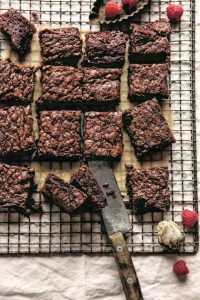 five ingredient hazelnut brownies. Nutella provides the chocolate and the fat for these brownies; but for one person, the result wasn’t nearly chocolatey enough. Another baker added the optional chocolate chips (which actually makes six ingredients!) and that definitely improved the chocolate flavor. They were super-quick to make and had a nice texture, so if you happen to have Nutella on hand it’s probably faster than a boxed brownie mix. And, though not a dessert, the no-knead bread and pizza dough was an incredibly fast, amazingly good pizza dough. The special sauce is 12 ounces of beer, which makes the dough soft, light, and easy to handle. The beer is faintly discernible in the finished product, so if you don’t like beer, that’s something to be aware of.
five ingredient hazelnut brownies. Nutella provides the chocolate and the fat for these brownies; but for one person, the result wasn’t nearly chocolatey enough. Another baker added the optional chocolate chips (which actually makes six ingredients!) and that definitely improved the chocolate flavor. They were super-quick to make and had a nice texture, so if you happen to have Nutella on hand it’s probably faster than a boxed brownie mix. And, though not a dessert, the no-knead bread and pizza dough was an incredibly fast, amazingly good pizza dough. The special sauce is 12 ounces of beer, which makes the dough soft, light, and easy to handle. The beer is faintly discernible in the finished product, so if you don’t like beer, that’s something to be aware of.
As you might surmise from all of the above, this title was a runaway success for everyone. As advertised, most of the recipes were simple, easy to put together, and used ingredients we had or that were easy to find. Best of all, they were enjoyable to eat! Ms. Gerard has just published a new cookbook, Half Baked Harvest Every Day, which will likely make its way into our rotation at some point! Unsurprisingly, when the votes were tallied, we averaged out to a 4.38 (out of a possible 5), one of our highest scores ever.
 Join us at our next meeting, on Friday, May 27 at 11 AM as we discuss NY Times writer and author Melissa Clark’s latest, Cooking in French. We will meet in hybrid format; please register online to attend either in-person or virtually. See you then!
Join us at our next meeting, on Friday, May 27 at 11 AM as we discuss NY Times writer and author Melissa Clark’s latest, Cooking in French. We will meet in hybrid format; please register online to attend either in-person or virtually. See you then!
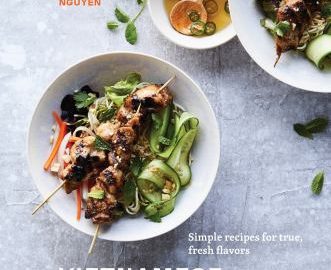
Bibliobites in March: In the Kitchen We’re Briefly Vietnamese
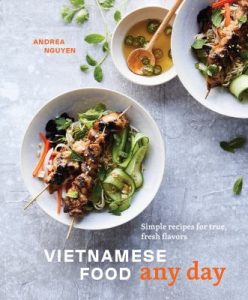 It was an exciting day for our Bibliobites group: in March we were able to meet in person for the first time in two years! The conversation was fast and furious as we caught up with each other and discussed our adventures with Vietnamese Food Any Day by Andrea Nguyen. This month’s title was chosen to connect with the library’s 2022 One Book title, On Earth We’re Briefly Gorgeous by Vietnamese-American author Ocean Vuong. Most of us are somewhat familiar with Viet food via the many restaurants in Lowell, and the flavors are similar to other Southeast Asian and Chinese cuisines; but for most (if not all) of us, cooking Vietnamese at home was a new experience. Author Nguyen goes out of her way to demystify ingredients and provide easy-to-find substitutions, and to illustrate commonalities with other dishes more frequently found in the US– so how did it play out for us in the kitchen?
It was an exciting day for our Bibliobites group: in March we were able to meet in person for the first time in two years! The conversation was fast and furious as we caught up with each other and discussed our adventures with Vietnamese Food Any Day by Andrea Nguyen. This month’s title was chosen to connect with the library’s 2022 One Book title, On Earth We’re Briefly Gorgeous by Vietnamese-American author Ocean Vuong. Most of us are somewhat familiar with Viet food via the many restaurants in Lowell, and the flavors are similar to other Southeast Asian and Chinese cuisines; but for most (if not all) of us, cooking Vietnamese at home was a new experience. Author Nguyen goes out of her way to demystify ingredients and provide easy-to-find substitutions, and to illustrate commonalities with other dishes more frequently found in the US– so how did it play out for us in the kitchen?
Because of its long history of colonial occupation, Vietnamese cuisine draws on a rich and diverse blend of influences, including French, Chinese, and American. 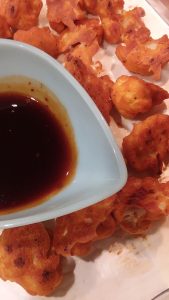 Roasted cauliflower wings were an “addictive” mashup of east and west, with crunchy batter-coated baked florets and a savory, spicy sauce for dipping. Charred brussels sprouts with coconut were “so good– the best!” Though the sprouts are not a typical Vietnamese vegetable, the “sweet tang” of coconut water, along with fish sauce, brought east and west together deliciously. Ubiquitous zucchini became a “yummy…very easy” side dish in easy soy-sauce glazed zucchini. Two readily available ingredients (soy sauce and chile garlic sauce) were all it took to create a memorable, quick to prepare dish. Baby kale stir-fried with garlic sounded enticing but was a bit tough and bitter, though this may have been the fault of the vegetable itself and not the recipe, “it wasn’t horrible.” And blistered green beans with bacon, while a very tasty stir-fry, was “a lot of work for green beans…I won’t bother with it again.”
Roasted cauliflower wings were an “addictive” mashup of east and west, with crunchy batter-coated baked florets and a savory, spicy sauce for dipping. Charred brussels sprouts with coconut were “so good– the best!” Though the sprouts are not a typical Vietnamese vegetable, the “sweet tang” of coconut water, along with fish sauce, brought east and west together deliciously. Ubiquitous zucchini became a “yummy…very easy” side dish in easy soy-sauce glazed zucchini. Two readily available ingredients (soy sauce and chile garlic sauce) were all it took to create a memorable, quick to prepare dish. Baby kale stir-fried with garlic sounded enticing but was a bit tough and bitter, though this may have been the fault of the vegetable itself and not the recipe, “it wasn’t horrible.” And blistered green beans with bacon, while a very tasty stir-fry, was “a lot of work for green beans…I won’t bother with it again.”
As always, we made lots of main dishes. Char siu chicken had a complex, slightly sweet marinade; the resulting grilled chicken was flavorful, moist, and “super-easy.” Two people tried ginger-garlic fish parcels. The fish was steamed en papillote; it was “pretty good…very easy,” though the flavors were “a bit muted.” Shrimp in coconut caramel sauce featured a luscious photo that our cook couldn’t resist; but the finished dish was “not very coconutty,” and the sauce took too long to reduce enough to coat the shrimp. The overall result– “meh!” 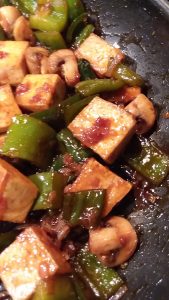 Spicy sweet pomegranate tofu made good use of pomegranate molasses, which some of us had bought (and still had lurking in the back of the fridge) when we reviewed a Middle Eastern cookbook last year. The tart, fruity syrup perfectly complemented the tofu and made a nicely sticky glaze, though one person thought it was a bit too tart. Unfortunately, the flavors in this dish faded appreciably in the fridge, and the lovely magenta color turned an unappealing grayish brown.
Spicy sweet pomegranate tofu made good use of pomegranate molasses, which some of us had bought (and still had lurking in the back of the fridge) when we reviewed a Middle Eastern cookbook last year. The tart, fruity syrup perfectly complemented the tofu and made a nicely sticky glaze, though one person thought it was a bit too tart. Unfortunately, the flavors in this dish faded appreciably in the fridge, and the lovely magenta color turned an unappealing grayish brown.
Since March is still mostly winter in these parts, we made some soups and stews, too: beef stew with star anise and lemongrass was “really good” with “a lot of flavor,” and like many stews, was even better the next day. Chicken, lemongrass, and sweet potato curry was an Indian/Viet mashup, as it used the familiar Indian curry blend (according to the author, in Vietnam Indian curry is preferred over Thai). This was “good” but both people who made it wished it was more lemony; perhaps the lemongrass was overshadowed by the two tablespoons of curry powder! It made a large potful and also aged well. Wontons in gingery broth “looked just like the photo” and were “light and tasty.” The author gives options for both vegetarian and meaty wonton fillings; either way this recipe is “a project,” but a delicious one! Pho is one of the most iconic Vietnamese dishes (Ms. Nguyen has written an entire book on the subject), and 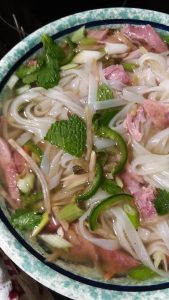 smoked turkey pho did not disappoint. This was a savory, warming combination of heady broth, smoky/salty turkey, and rice noodles complemented by mint and chile. Though a simplified version of the classic, it was still relatively time-consuming; and worth every minute.
smoked turkey pho did not disappoint. This was a savory, warming combination of heady broth, smoky/salty turkey, and rice noodles complemented by mint and chile. Though a simplified version of the classic, it was still relatively time-consuming; and worth every minute.
There are only a few desserts in this book, but one of them called to multiple people: no-churn vietnamese coffee ice cream. This way of making ice cream has been well-publicized on the internet; it’s typically a combination of sweetened condensed milk and whipped cream. No ice cream maker is required, yet the result was smooth, creamy, and loaded with coffee flavor. There’s also a variation including chocolate chips. Talk about gilding the lily! Definitely a keeper.
This title is a solid and enjoyable introduction to Vietnamese cooking. The author provides plenty of general information and tips for us newbies. There’s also a chapter on ingredients, where you might find them, and substitutions. We liked Ms. Nguyen’s no-nonsense, use-what-you-can-find attitude, and her embrace of newfangled cooking tools like the multicooker (Instant Pot). The photos in the book are top-notch, though we wished for a few more. And the type could have been a wee bit larger– but these are small complaints! Voting reflected our good vibes: we averaged out to a 3.8 (out of a possible 5). If you want to cook more Vietnamese, check out Ms. Nguyen’s other titles. She’s also on YouTube, and has a website, https://www.vietworldkitchen.com/. And if you just want to sample Vietnamese cuisine, there are several restaurants nearby in Lowell, which has a significant Vietnamese and Cambodian population. Easy to get your pho fix anytime!
 For our next meeting on April 29th at 11 AM, we’ll be simplifying a bit with blogger Tieghen Gerard’s Half-Baked Harvest Super Simple. Copies are available at the main circulation desk or via curbside pickup. We will meet in hybrid format; please register for either in-person or remote attendance. See you there!
For our next meeting on April 29th at 11 AM, we’ll be simplifying a bit with blogger Tieghen Gerard’s Half-Baked Harvest Super Simple. Copies are available at the main circulation desk or via curbside pickup. We will meet in hybrid format; please register for either in-person or remote attendance. See you there!
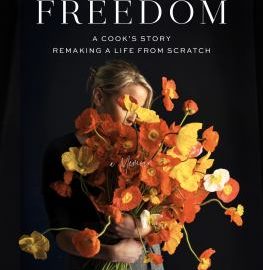
Bibliobites in February: Finding Resilience, Finding Strength
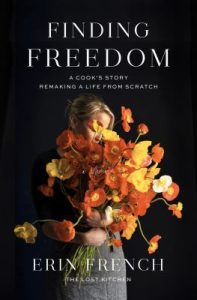 Winter hadn’t quite released its grip when our Bibliobites group met on an unexpectedly snowy morning. Though two days prior the temperature had hit 60 degrees, on the day of our meeting the snow steadily accumulated outside as we talked (via zoom) about Erin French’s bestselling memoir, Finding Freedom. Ms. French is the owner/chef of The Lost Kitchen in Freedom, ME, which has been consistently named one of the best restaurants in the country. It’s also one of the hardest to get into—reservations are created using a lottery system with over 20,000 postcard entrants annually! But, if we can’t go there, at least we can read about the restaurant and its talented and dedicated chef.
Winter hadn’t quite released its grip when our Bibliobites group met on an unexpectedly snowy morning. Though two days prior the temperature had hit 60 degrees, on the day of our meeting the snow steadily accumulated outside as we talked (via zoom) about Erin French’s bestselling memoir, Finding Freedom. Ms. French is the owner/chef of The Lost Kitchen in Freedom, ME, which has been consistently named one of the best restaurants in the country. It’s also one of the hardest to get into—reservations are created using a lottery system with over 20,000 postcard entrants annually! But, if we can’t go there, at least we can read about the restaurant and its talented and dedicated chef.
It’s hard to know where to start in summarizing our discussion. There’s so much in this story that’s dramatic and heart-wrenching; her life has had so many twists and turns that if you didn’t know it was true you might think you were reading fiction. And, as with many memoirs, this story hinges on relationships: to family, spouse, child; and of course, food and cooking.
 Ms. French had an idyllic, and difficult, childhood in rural Maine. Her father, who owned a local diner, was unstable and verbally abusive. Fixated on having sons, he was perpetually disappointed that his children were girls (“…get over it!”). Despite his disdain for daughters, he had no trouble putting Ms. French to work in the diner beginning at age 12, and by the time she was in high school, she was essentially a full time cook, and often the only cook. And yet, throughout the book, she is steadfast in her appreciation for the direction in which her father inadvertently steered her: she discovered a passion for food and cooking that endured and has sustained her into the present. Our group was amazed at her level of forgiveness towards her dad; she chose how to write about it, and “wrote through a lens of love.” It was “beautiful….she praised what she could.”
Ms. French had an idyllic, and difficult, childhood in rural Maine. Her father, who owned a local diner, was unstable and verbally abusive. Fixated on having sons, he was perpetually disappointed that his children were girls (“…get over it!”). Despite his disdain for daughters, he had no trouble putting Ms. French to work in the diner beginning at age 12, and by the time she was in high school, she was essentially a full time cook, and often the only cook. And yet, throughout the book, she is steadfast in her appreciation for the direction in which her father inadvertently steered her: she discovered a passion for food and cooking that endured and has sustained her into the present. Our group was amazed at her level of forgiveness towards her dad; she chose how to write about it, and “wrote through a lens of love.” It was “beautiful….she praised what she could.”
Though Ms. French has a sister, we didn’t get a good feel for that relationship. It was clear that they weren’t (and perhaps aren’t) close, but there was “not a good overall picture.” Her mom is depicted as a strong, loving, yet passive presence; a woman who found it difficult to cope with and stand up to her harsh and spiteful husband.
Much of our discussion focused on Ms. French’s husband, Tom. Like her father, Tom was an alcoholic; and though he initially supported her dreams (both financially and emotionally), things began to fall apart when she started to gain acclaim for her small restaurant in Belfast, ME (also called the Lost Kitchen). At that point, their marriage was struggling and Ms. French was developing a raging addiction to alcohol and prescription meds as she tried to keep everything in her life on a semi-even keel. When she finally went to rehab, he closed the successful restaurant, and sold everything in it. Though Ms. French didn’t know it at the time, only Tom legally owned the business. Until he shuttered the restaurant, we were kind of OK with Tom (he’d helped her start the restaurant, adopted her son from a prior relationship, and had stopped drinking), but then “he kicked her when she was down.” It seemed that he wanted to punish her in every way possible, “I’m going to make her miserable,” since she wanted to leave her marriage. We wondered if Ms. French ever really loved him; she “sort of slid into it” and it gave her some security; “she didn’t have a good model growing up.” In addition to destroying her restaurant business, because of her addiction he obtained a court order to prevent her from seeing her son.
 To dig yourself out from under addiction, the loss of your livelihood that you had built from scratch, betrayal by your husband, and the forced separation from your child– it’s almost too much to imagine any one human being surviving all of that. And yet she did survive, and start over, both personally and professionally. What saved her? In the book she gives all the credit to her love for her son, and the support of her mother– but we also thought her passion for food and cooking kept her going; “she could envision what she was reaching for.” But even with a strong vision, it took so much hard work, determination, and patience to restart her dream, “I’m in awe of this woman.” Unsurprisingly, this was an emotional and inspirational read for all of us; it “takes a lot of guts to empty your soul [onto the page].” We thought that maybe writing it all down was a form of therapy for her, literally closing the book on some painful chapters.
To dig yourself out from under addiction, the loss of your livelihood that you had built from scratch, betrayal by your husband, and the forced separation from your child– it’s almost too much to imagine any one human being surviving all of that. And yet she did survive, and start over, both personally and professionally. What saved her? In the book she gives all the credit to her love for her son, and the support of her mother– but we also thought her passion for food and cooking kept her going; “she could envision what she was reaching for.” But even with a strong vision, it took so much hard work, determination, and patience to restart her dream, “I’m in awe of this woman.” Unsurprisingly, this was an emotional and inspirational read for all of us; it “takes a lot of guts to empty your soul [onto the page].” We thought that maybe writing it all down was a form of therapy for her, literally closing the book on some painful chapters.
And speaking of writing, we thought this memoir was well written– it was compelling and moved along at good pace. Ms. French’s honesty was appealing, and her lack of chef-ish ego refreshing. Her lyrical descriptions of food have been widely praised, and we agreed that those accolades were well-deserved. Before Ms. French published her memoir, she did produce a cookbook, appropriately titled 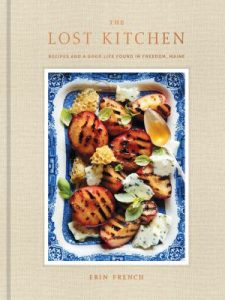 The Lost Kitchen. A few of us had paged through this; as with the memoir we enjoyed her writing, and the photography is incredible, both of the food and the restaurant and its surroundings. But, despite Ms. French’s claims of being a plain, no-frills cook, we thought that the food was a bit too “fancy.” As someone pointed out, she sources her incredibly high-quality ingredients hyper-locally, in a way we might not be able to. In many ways, her food is of her specific place, which is a good thing– but it makes it harder to duplicate in another location. Or, maybe we don’t really want to cook her food ourselves, we just want to go to the restaurant! The chances of any of us doing that are quite small, but I’m sure most of us will be sending a postcard to Freedom, Maine on April 1. In the meantime, if you want more Erin French in your life, the audiobook, read by the author, is highly recommended. And, there’s now a TV show about the Lost Kitchen (“a great adjunct”) on Magnolia Network.
The Lost Kitchen. A few of us had paged through this; as with the memoir we enjoyed her writing, and the photography is incredible, both of the food and the restaurant and its surroundings. But, despite Ms. French’s claims of being a plain, no-frills cook, we thought that the food was a bit too “fancy.” As someone pointed out, she sources her incredibly high-quality ingredients hyper-locally, in a way we might not be able to. In many ways, her food is of her specific place, which is a good thing– but it makes it harder to duplicate in another location. Or, maybe we don’t really want to cook her food ourselves, we just want to go to the restaurant! The chances of any of us doing that are quite small, but I’m sure most of us will be sending a postcard to Freedom, Maine on April 1. In the meantime, if you want more Erin French in your life, the audiobook, read by the author, is highly recommended. And, there’s now a TV show about the Lost Kitchen (“a great adjunct”) on Magnolia Network.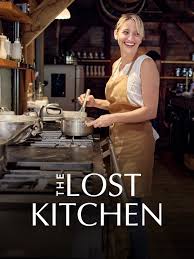
When our votes were tallied, we averaged out to a 4.8 (out of a possible 5). That may well be our highest score ever. Seems fitting!
We’ll next meet on Friday, March 25 at 11 AM. This meeting will be in a hybrid format; you may attend in person (in the McCarthy Meeting Room) or via Zoom. Please register for either; zoom link will be sent on the morning of the program. In conjunction with Chelmsford’s One Book title, On Earth We’re Briefly Gorgeous by Vietnamese-American poet Ocean Vuong, we’ll be discussing Vietnamese Food Any Day by Andrea Nguyen. Hope to see you then!
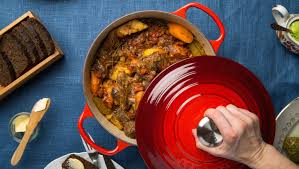
Bibliobites in January: Appetizing Adventures
 Serious winter is upon us. It’s cold, it’s snowy or icy or rainy (or all three!), and the sun makes far fewer appearances than most of us would like. To add insult to injury, it’s still getting dark so early that PJs at 6 PM seems like the only sensible thing to do. But, as we slowly slog towards spring, we can always enjoy the great indoors of our kitchens. Winter is the perfect time to explore new cuisines, try something out of our comfort zone, and spend a few leisurely hours cooking or baking something warming and delicious. Our group was more than up for the challenge for the January theme of “choose your own adventure,” and we hope our experiences will inspire you to do the same.
Serious winter is upon us. It’s cold, it’s snowy or icy or rainy (or all three!), and the sun makes far fewer appearances than most of us would like. To add insult to injury, it’s still getting dark so early that PJs at 6 PM seems like the only sensible thing to do. But, as we slowly slog towards spring, we can always enjoy the great indoors of our kitchens. Winter is the perfect time to explore new cuisines, try something out of our comfort zone, and spend a few leisurely hours cooking or baking something warming and delicious. Our group was more than up for the challenge for the January theme of “choose your own adventure,” and we hope our experiences will inspire you to do the same.
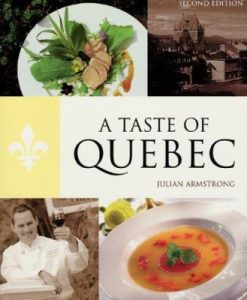 Most of us chose a book (or books!) to delve into; this provided a nice framework for trying out a less-familiar cuisine or technique. One person decided to explore her French Canadian roots with A Taste of Quebec. This turned out to be almost a combination travel guide and cookbook; there was plentiful information about various regional foods and their origins, “now I want to go visit!” This title featured many meaty dishes, such as the iconic tourtière, a hearty meat pie that helps Québécois get through their long winters. Root vegetables are also a common cold-weather ingredient, so our cook made a turnip soufflé, which elevated the humble turnip into something special, though “it did need an onion to sweeten it.”
Most of us chose a book (or books!) to delve into; this provided a nice framework for trying out a less-familiar cuisine or technique. One person decided to explore her French Canadian roots with A Taste of Quebec. This turned out to be almost a combination travel guide and cookbook; there was plentiful information about various regional foods and their origins, “now I want to go visit!” This title featured many meaty dishes, such as the iconic tourtière, a hearty meat pie that helps Québécois get through their long winters. Root vegetables are also a common cold-weather ingredient, so our cook made a turnip soufflé, which elevated the humble turnip into something special, though “it did need an onion to sweeten it.”
 January’s tradition of making New Year’s resolutions to improve eating habits was a theme for some. One person experimented with vegan cooking using Plant Powered Families. Though the book overall wasn’t a huge hit, she did find some worthy keepers: smoky bean chili (“very good– better than your typical vegetarian chili”), chickpea rice soup (“really hearty, good for winter”) and thick and hearty tomato sauce (“it used red lentils to thicken, which I really liked”). Still on tap, a chocolate pudding with chia seeds, since she was curious to try these now-common seeds. Another group member checked out the optimistically titled
January’s tradition of making New Year’s resolutions to improve eating habits was a theme for some. One person experimented with vegan cooking using Plant Powered Families. Though the book overall wasn’t a huge hit, she did find some worthy keepers: smoky bean chili (“very good– better than your typical vegetarian chili”), chickpea rice soup (“really hearty, good for winter”) and thick and hearty tomato sauce (“it used red lentils to thicken, which I really liked”). Still on tap, a chocolate pudding with chia seeds, since she was curious to try these now-common seeds. Another group member checked out the optimistically titled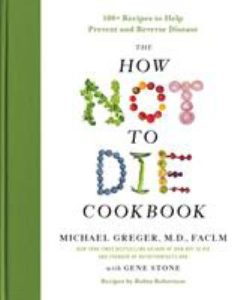 How Not to Die Cookbook. This book was “very, very healthy;” so healthy that the recipes did not appeal, “I marked a few, but didn’t use the book.” Some ingredients were off-putting (nutritional yeast), and there was lots of prep (many recipes called for spice mixes you made ahead of time). So, our cook moved on to some Eating Well newsletters she had piling up in an email folder. This was much more successful, producing several tasty meals like zucchini spinach gouda bake (“like a quiche, but drier”), cauliflower pizza crust (“not really a pizza– like a really thin potato pancake…you can’t eat it by hand”), creamy white chili (“more like soup, not thick enough…very smooth!”), one pot chicken Alfredo (“will make again!”), and slow cooker barbecued brisket (“pretty good…made a lot!”). Not to neglect dessert, she flipped through Baking With Less Sugar, and baked some fudgy mascarpone brownies.
How Not to Die Cookbook. This book was “very, very healthy;” so healthy that the recipes did not appeal, “I marked a few, but didn’t use the book.” Some ingredients were off-putting (nutritional yeast), and there was lots of prep (many recipes called for spice mixes you made ahead of time). So, our cook moved on to some Eating Well newsletters she had piling up in an email folder. This was much more successful, producing several tasty meals like zucchini spinach gouda bake (“like a quiche, but drier”), cauliflower pizza crust (“not really a pizza– like a really thin potato pancake…you can’t eat it by hand”), creamy white chili (“more like soup, not thick enough…very smooth!”), one pot chicken Alfredo (“will make again!”), and slow cooker barbecued brisket (“pretty good…made a lot!”). Not to neglect dessert, she flipped through Baking With Less Sugar, and baked some fudgy mascarpone brownies. 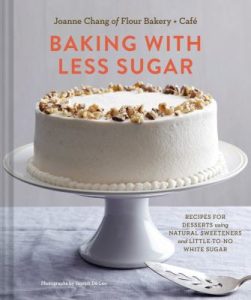 These were indeed fudgy with good chocolate flavor, and did use 1/3 less sugar than a more traditional recipe. And with the leftover mascarpone, how about some lower sugar cheesecake? This was “so so good– the most delicious ever!” It also froze well, and if you are impatient, it was “even tasty half-frozen!”
These were indeed fudgy with good chocolate flavor, and did use 1/3 less sugar than a more traditional recipe. And with the leftover mascarpone, how about some lower sugar cheesecake? This was “so so good– the most delicious ever!” It also froze well, and if you are impatient, it was “even tasty half-frozen!”
Since January is also “get organized month,” (and another frequent New Year’s resolution), a second group member decided to work on some recipes awaiting her attention in her email. She used a list of the most popular viral TikTok recipes of 2021. Baked feta pasta was easy and delicious, if a bit salty; “will definitely try again.” Creamy ramen sounded interesting and different; it was “tasty– but still kind of weird.” The creaminess and the ramen were an unusual combo. Still, it was intriguing enough to try again, perhaps with some added veggies or protein to make more of a complete meal. We thought sheet pan pancake was a simple, and simply genius, idea: you pour your pancake batter into a sheet pan, bake, and then cut into squares or triangles to serve. Great for a crowd or to make ahead and reheat on a busy morning. This recipe is very similar to one that has been featured by Ree Drummond on her Pioneer Woman TV show. Vegan carrot bacon is still on deck, but the idea is so unexpected, and the picture looks so “awesome” that it’s a must-try.
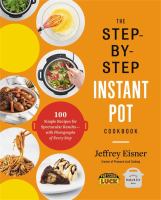 And January is definitely soup season, so one person undertook a one-woman soup festival. A fan of the instant pot, she made split pea soup from her go-to title, The Step By Step Instant Pot Cookbook. This was an excellent version of pea soup, and we also got a useful pro tip: the Honey Baked Ham store in Nashua sells ham bones, which are pretty much a requirement for pea soup. Ham bones also figure in the iconic Senate bean soup, which our cook planned to try the day after we met, so no report back yet! Chunky tomato soup was another instant pot success, quick to put together and mellowed with cream cheese added at the end. And hearty homemade corn chowder (from the Chunky Chef blog) was easy and “really good…I’d never made corn chowder before!” Our soup maven then moved on to
And January is definitely soup season, so one person undertook a one-woman soup festival. A fan of the instant pot, she made split pea soup from her go-to title, The Step By Step Instant Pot Cookbook. This was an excellent version of pea soup, and we also got a useful pro tip: the Honey Baked Ham store in Nashua sells ham bones, which are pretty much a requirement for pea soup. Ham bones also figure in the iconic Senate bean soup, which our cook planned to try the day after we met, so no report back yet! Chunky tomato soup was another instant pot success, quick to put together and mellowed with cream cheese added at the end. And hearty homemade corn chowder (from the Chunky Chef blog) was easy and “really good…I’d never made corn chowder before!” Our soup maven then moved on to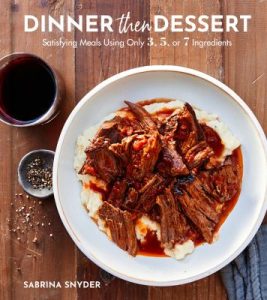 Dinner Then Dessert: Satisfying Meals Using Only 3, 5, or 7 Ingredients. This book proved to be a winner, since “her pantry is (stocked) like mine,” which made dinner prep a snap. Keepers included mushroom stroganoff, and the easy stir-fry garlic shrimp with oyster sauce. Note that many of the author’s recipes are available online, if you want to road-test the concept.
Dinner Then Dessert: Satisfying Meals Using Only 3, 5, or 7 Ingredients. This book proved to be a winner, since “her pantry is (stocked) like mine,” which made dinner prep a snap. Keepers included mushroom stroganoff, and the easy stir-fry garlic shrimp with oyster sauce. Note that many of the author’s recipes are available online, if you want to road-test the concept.
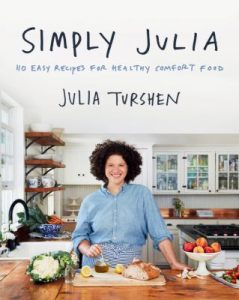 Another group member decided to tackle the invitingly titled Simply Julia: 110 Recipes for Healthy Comfort Food. This title received much praise when it was published, but our group member was unimpressed. This book is the ever-more-common mashup of blog and cookbook, and for our reviewer, it was way too much talk and not enough action. There are numerous two-page essays in the book (on various food-related topics), and copious headnotes; many love this window into an author’s world, but some prefer to stay happily ignorant and just go straight to the recipes. And speaking of the recipes: spinach and artichoke dip chicken bake was “OK” but “kind of dry” despite a cup of sour cream. Doug’s tex-mex turkey meatballs were super easy with only 5 ingredients; they used a cup of salsa, which was the dominant flavor; these were also “OK” though not outstanding. Future possibilities include Grace’s green beans, braised red cabbage and green apples, and carrot and chickpea korma.
Another group member decided to tackle the invitingly titled Simply Julia: 110 Recipes for Healthy Comfort Food. This title received much praise when it was published, but our group member was unimpressed. This book is the ever-more-common mashup of blog and cookbook, and for our reviewer, it was way too much talk and not enough action. There are numerous two-page essays in the book (on various food-related topics), and copious headnotes; many love this window into an author’s world, but some prefer to stay happily ignorant and just go straight to the recipes. And speaking of the recipes: spinach and artichoke dip chicken bake was “OK” but “kind of dry” despite a cup of sour cream. Doug’s tex-mex turkey meatballs were super easy with only 5 ingredients; they used a cup of salsa, which was the dominant flavor; these were also “OK” though not outstanding. Future possibilities include Grace’s green beans, braised red cabbage and green apples, and carrot and chickpea korma.
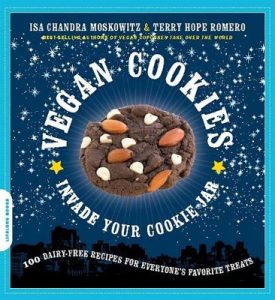
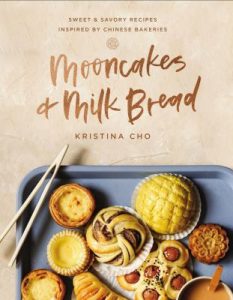
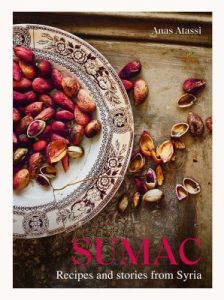
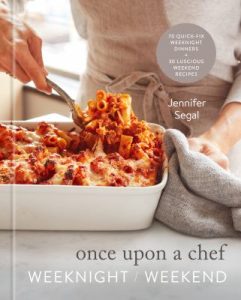
Other titles we dipped into included Vegan Cookies Invade Your Cookie Jar (“everything I’ve tried has been yummy and easy!”); Mooncakes and Milk Bread (“different- mostly sweet recipes you’d find in a Chinese bakery– the crispy Chinese sausage and cilantro pancakes were a project, but so good!”); Sumac: Recipes and Stories From Syria (“delicious simple, non-intimidating Middle Eastern food”); Pasta (“an exhaustive tome of pasta-making, definitely a project”), Once Upon a Chef (“loved it– these are the kinds of recipes I like. I might buy it.”); Bittman Bread (“interesting and a little different. You need a starter for everything. For a future project!”). And even though our theme was cooking, some also perused memoirs they’d recommend: Out of Line by local chef Barbara Lynch, and Into the Weeds: Around the World and Behind the Scenes with Anthony Bourdain by Tom Vitale.
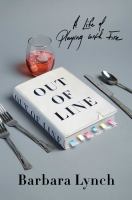

Phew! That’s a lot of cooking and trying new things. And speaking of memoir, next month we’ll be reading Erin French’s gripping chronicle, Finding Freedom. Ms. French, proprietor of The Lost Kitchen (“one of the 50 best restaurants in the world”) in Freedom, ME takes us through the difficult and winding road that has ultimately led to her incredible success. Copies are available at the main circulation desk or via curbside pickup. We’ll next meet on Friday, February 25 at 11 AM. Plan to chat via zoom; link will be emailed on the morning of the program.
Stay warm and cook on!

Bibliobites in November/December: Flour Power
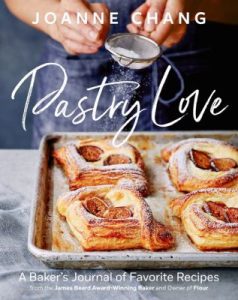 Local legend/pastry queen/James Beard Award winner Joanne Chang is a very busy baker indeed. In addition to running the nine locations of her well-loved Flour Bakery and Cafe, she’s written five cookbooks, and with her husband, chef Christopher Myers, she owns Myers + Chang, a pan-Asian restaurant in Boston. Plus, she’s recently somehow found the time to appear as a judge on the Netflix series Baking Impossible. I’d say it’s her daily schedule that must verge on the impossible! Way back in 2015, our group reviewed Ms. Chang’s first baking book; this month we tackled her newest, Pastry Love. After spending more than a month with butter, sugar, and plenty of chocolate, did we think this title was a worthy successor?
Local legend/pastry queen/James Beard Award winner Joanne Chang is a very busy baker indeed. In addition to running the nine locations of her well-loved Flour Bakery and Cafe, she’s written five cookbooks, and with her husband, chef Christopher Myers, she owns Myers + Chang, a pan-Asian restaurant in Boston. Plus, she’s recently somehow found the time to appear as a judge on the Netflix series Baking Impossible. I’d say it’s her daily schedule that must verge on the impossible! Way back in 2015, our group reviewed Ms. Chang’s first baking book; this month we tackled her newest, Pastry Love. After spending more than a month with butter, sugar, and plenty of chocolate, did we think this title was a worthy successor?
The book itself was praised for its production values: nice heavy paper, stunning photography, and the typical large format. The contents cover a wide range, from breakfast treats to breads to confections. We loved Ms. Chang’s writing style; she’s clear and precise, and her instructions are very detailed. We also liked that her recipes feature both volume and weight measurements, so no matter which method you prefer, you don’t have to waste time on tedious conversions. On the downside, the font is fairly small and the text color is light gray, rather than black. We’ve noticed this trend towards gray printing in cookbooks, and while it’s visually pleasant, it is more difficult to read. Cookbook editors, please take note!
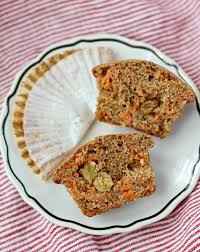 Once the oven was turned on, and our ingredients were properly at room temperature, did our group of mostly non-bakers enjoy the results of their efforts? For starters, the breakfast chapter was a winner, featuring yummy treats that were quick and easy. Three people made vegan carrot-ginger muffins; these were “hearty” and “really good warm” with plenty of flavor and texture from the carrots, raisins, and walnuts. One person tried reducing the sugar, but this didn’t improve things; the resulting muffins were “bland.”
Once the oven was turned on, and our ingredients were properly at room temperature, did our group of mostly non-bakers enjoy the results of their efforts? For starters, the breakfast chapter was a winner, featuring yummy treats that were quick and easy. Three people made vegan carrot-ginger muffins; these were “hearty” and “really good warm” with plenty of flavor and texture from the carrots, raisins, and walnuts. One person tried reducing the sugar, but this didn’t improve things; the resulting muffins were “bland.”  Even better were the vegan chocolate-banana muffins, “absolutely delicious–a keeper!” Maple-blueberry scones also more than made the grade; these jumbo-sized treats feature whole-wheat flour and plenty of blueberries, “we ate lots!” Two people tried
Even better were the vegan chocolate-banana muffins, “absolutely delicious–a keeper!” Maple-blueberry scones also more than made the grade; these jumbo-sized treats feature whole-wheat flour and plenty of blueberries, “we ate lots!” Two people tried  ricotta-cherry scones; these were “very tasty” and looked gorgeous, too. Two caveats: the scones contain some expensive ingredients (frozen and dried cherries, creme fraiche), and the scones are of the biscuit (rather than the flaky) style– which one cook realized is not her preferred type.
ricotta-cherry scones; these were “very tasty” and looked gorgeous, too. Two caveats: the scones contain some expensive ingredients (frozen and dried cherries, creme fraiche), and the scones are of the biscuit (rather than the flaky) style– which one cook realized is not her preferred type.
Moving on to the ever-enticing cookie department, we enjoyed several recipes that are the convenient slice-and-bake variety; we discovered that all of these doughs freeze well, definitely a bonus. Pecan sandies were a “really good…not too sweet” version of this classic. The dough was a bit crumbly but manageable, and the cookies kept well. Lemon-polenta cookies, a signature treat at the bakery, had a bit of pleasant grit from the cornmeal, and bright lemon flavor. These also remained fresh-tasting for at least a week and were just right with a cup of tea. 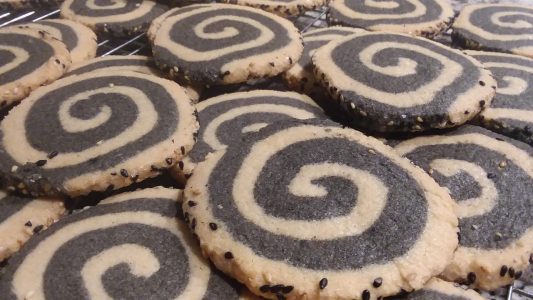 Spiral shortbreads are perfect for the sesame enthusiast; they feature both black and “regular” tahini and are rolled in sesame seeds. These cookies were rich and subtly savory, and also had a nice trompe l’oeil effect– they look like they’re chocolate and vanilla, but they aren’t! Black tahini isn’t widely available, but Asian markets carry it, and of course it can be ordered online. We baked drop cookies, too: thin, crispy chocolate chip cookies were just that– large, buttery, and loaded with chips, “will definitely make again!” Our cook thought they were maybe “a bit too sweet” but it was a minor complaint. And in the warmer months, “they’d be good to use for making ice cream sandwiches.” Vegan almond macaroons used aquafaba, that trendy egg substitute, but all did not turn out perfectly. The dough was quite sticky and therefore a bit difficult to work with, and the cookies were reluctant to turn brown (the doneness test), so they wound up overbaked– beyond crunchy! Gluten-free Persian love cookies were “pretty good” with their almond flour base; our baker changed up the flavorings to accommodate what she had available, so they weren’t really “Persian,” but they were good enough that, “I will try again.” And if you enjoy rich, dark chocolate flavor, try the
Spiral shortbreads are perfect for the sesame enthusiast; they feature both black and “regular” tahini and are rolled in sesame seeds. These cookies were rich and subtly savory, and also had a nice trompe l’oeil effect– they look like they’re chocolate and vanilla, but they aren’t! Black tahini isn’t widely available, but Asian markets carry it, and of course it can be ordered online. We baked drop cookies, too: thin, crispy chocolate chip cookies were just that– large, buttery, and loaded with chips, “will definitely make again!” Our cook thought they were maybe “a bit too sweet” but it was a minor complaint. And in the warmer months, “they’d be good to use for making ice cream sandwiches.” Vegan almond macaroons used aquafaba, that trendy egg substitute, but all did not turn out perfectly. The dough was quite sticky and therefore a bit difficult to work with, and the cookies were reluctant to turn brown (the doneness test), so they wound up overbaked– beyond crunchy! Gluten-free Persian love cookies were “pretty good” with their almond flour base; our baker changed up the flavorings to accommodate what she had available, so they weren’t really “Persian,” but they were good enough that, “I will try again.” And if you enjoy rich, dark chocolate flavor, try the 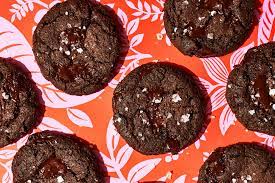 double chocolate rye cookies. These are a little bit fussy to make, but worth every minute, with their slightly crisp edges and tender mousse-like interior studded with chocolate chunks. Most definitely a keeper!
double chocolate rye cookies. These are a little bit fussy to make, but worth every minute, with their slightly crisp edges and tender mousse-like interior studded with chocolate chunks. Most definitely a keeper!
We didn’t venture far beyond breakfast and cookies; but one person did make olive oil cake with fresh grapes. Our intrepid baker didn’t have any grapes on hand, but made the cake anyway, and then discovered “it really needed the grapes” for both sweetness and acidity. The cake was fairly dense and “a bit greasy” which can happen with oil-based cakes. This was a recipe that would benefit from some personal tweaking to accommodate particular preferences. Japanese cotton cheesecake turned into a bit of a flop, partly because of the pan called for: an 8″ x 3″ round pan. Many of us might have an 8″ round pan, but your standard cake pan is only 2″ deep. So, our baker used a springform pan which (as they sometimes will) leaked a bit, and also allowed water from the water bath to seep in. It was really an engineering problem, not a recipe problem; but this and other complications resulted in a cake that was not fluffy as advertised. After a frustrating afternoon, “I might try again!”
turned into a bit of a flop, partly because of the pan called for: an 8″ x 3″ round pan. Many of us might have an 8″ round pan, but your standard cake pan is only 2″ deep. So, our baker used a springform pan which (as they sometimes will) leaked a bit, and also allowed water from the water bath to seep in. It was really an engineering problem, not a recipe problem; but this and other complications resulted in a cake that was not fluffy as advertised. After a frustrating afternoon, “I might try again!”
Overall, we enjoyed this title. Even those who only had the time or energy for just a little pastry love thought that “everything looked so good!” We liked many of the author’s takes on classic recipes, and it was fun to bake treats that we’d seen/eaten at the bakery. As much as some of us like to bake, what we all really want is a Flour Bakery a little closer to home. What about it, Ms. Chang? Isn’t it time to branch out to the real suburbs (as in, out along 95/128)? Everyone in our group would undoubtedly become a loyal customer.
Our voting reflected our positive experiences, and the good vibes generated by Ms. Chang’s friendly and genuine “voice.” We averaged out to a 3.8 (out of a possible 5). That’s a pretty stellar score for this group!
We’ll next meet via zoom on Friday, January 28 at 11 AM. This month’s theme is “Choose Your Own Adventure:” pick a title from a reserved cart of books at the main circulation desk, or choose one of your own. The idea is to try something new and/or different. If you would like to attend and are not on our email list, you can sign up here to receive the zoom link.
Happy New Year, and see you on the 28th!
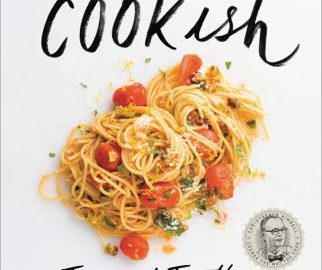
Bibliobites in October: Milking It
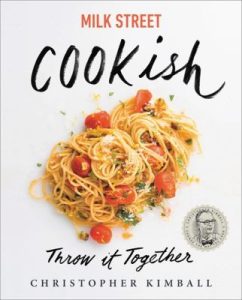 Christopher Kimball has almost single-handedly transformed the world of home cooking. Love him or hate him (and there are fierce advocates on both sides), his reach and influence are undeniable. He founded Cook’s Magazine in the 1980s, which begat Cook’s Illustrated in the 1990s, which then morphed into the America’s Test Kitchen empire, which includes print, radio, television, and web. Phew! In 2015, he abruptly departed ATK and founded Christopher Kimball’s Milk Street, a magazine that has since diversified into radio, television, web, and— cookbooks! Which brings us to October’s title, Cookish. Milk Street’s tagline is “changing the way you cook,” and this book’s variation on that is “throw it together” using six ingredients or fewer and (mostly) taking 30 minutes or less. We’ve test-driven this concept before (with Jamie Oliver) and were unimpressed. Could this newer riff on that idea turn us into true believers?
Christopher Kimball has almost single-handedly transformed the world of home cooking. Love him or hate him (and there are fierce advocates on both sides), his reach and influence are undeniable. He founded Cook’s Magazine in the 1980s, which begat Cook’s Illustrated in the 1990s, which then morphed into the America’s Test Kitchen empire, which includes print, radio, television, and web. Phew! In 2015, he abruptly departed ATK and founded Christopher Kimball’s Milk Street, a magazine that has since diversified into radio, television, web, and— cookbooks! Which brings us to October’s title, Cookish. Milk Street’s tagline is “changing the way you cook,” and this book’s variation on that is “throw it together” using six ingredients or fewer and (mostly) taking 30 minutes or less. We’ve test-driven this concept before (with Jamie Oliver) and were unimpressed. Could this newer riff on that idea turn us into true believers?
We were all certainly attracted to the notion of speedy and delicious. But in order to meet this goal, we discovered that a fair number of condiments are required. Logically enough, if you want your end result to be flavorful, and you’re cutting flavor-developing time out of the equation, you need to start with assertive ingredients. Accordingly, there was lots of soy sauce, fish sauce, hoisin, curry, smoked paprika, many types of chilies, lots of garlic– you get the idea! This approach worked well, except when it didn’t!
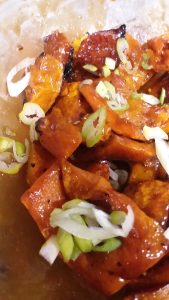 In the “it really worked department,” four of us made roasted butternut squash with hoisin and chives (October is butternut squash month?). Three of us adored this simple, colorful combination, and thought the pairing of squash and hoisin was inspired. For one person with a squash traditionalist in the household, it was just “OK” but it’s a keeper for the rest of us. Barley risotto with leeks and mushrooms turned out to be an “awesome” take on the classic combination of barley and mushrooms; and toasted bulgur and lentil soup was likewise “fantastic,” accented with garlic and lemon zest. Broiled caribbean mahi mahi was another hit with its herby/citrus-y sauce; as a bonus “it looked just like the photo!” There were several well-liked chicken dishes: moroccan chicken skewers (“very tasty”), spiced ground chicken with currants and pistachios (“unusual combo but very good– Middle Eastern-ish”),
In the “it really worked department,” four of us made roasted butternut squash with hoisin and chives (October is butternut squash month?). Three of us adored this simple, colorful combination, and thought the pairing of squash and hoisin was inspired. For one person with a squash traditionalist in the household, it was just “OK” but it’s a keeper for the rest of us. Barley risotto with leeks and mushrooms turned out to be an “awesome” take on the classic combination of barley and mushrooms; and toasted bulgur and lentil soup was likewise “fantastic,” accented with garlic and lemon zest. Broiled caribbean mahi mahi was another hit with its herby/citrus-y sauce; as a bonus “it looked just like the photo!” There were several well-liked chicken dishes: moroccan chicken skewers (“very tasty”), spiced ground chicken with currants and pistachios (“unusual combo but very good– Middle Eastern-ish”), 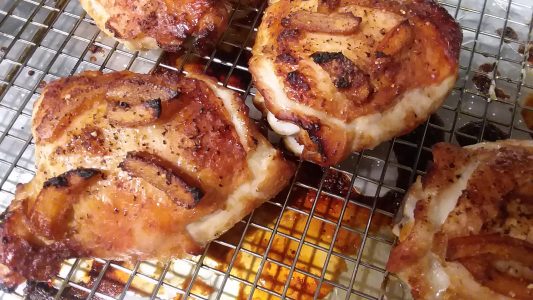 orange-ginger chicken (“easy and delicious version of a classic”), and spicy stir-fried chicken and snow peas, which was only “pretty good,” but “better the second day.”
orange-ginger chicken (“easy and delicious version of a classic”), and spicy stir-fried chicken and snow peas, which was only “pretty good,” but “better the second day.”
The section on one-pot pastas proved to be a big hit; there was praise for the less-water one-pot method, which was new to us. Gemelli with tomatoes, salami, and fontina was a bit on the spicy side (our cook used pepperoni, a listed alternative), but overall this combination hit the mark, and was excellent left over. Penne arrabiata was a keeper: quick, easy, and flavorful with its fresh basil, pecorino cheese, and red pepper flakes. And, lest we forget, only one pot to wash!
We were on the fence about some recipes; most of the following got at best an “OK” from our cooks: sweet and savory skillet-steamed eggplant, mustard-roasted cauliflower (“it was fine…”), skillet-charred brussels sprouts with coriander and cashews (“cashews surprisingly didn’t add much…wouldn’t rush out and make again”), chutney-roasted eggplant with scallions (“good– looked exactly like the picture”), ramen salad with shrimp and scallions (“nothing special– ramen with soy sauce”), chili-soy noodles with bok choy and peanuts (“OK– I have other similar recipes that are better”), and soupy rice with mushrooms and greens (“better the second night, flavors needed to meld”). Pork, sweet pepper, and cabbage stew turned out to be “a nerve-shattering experience,” as our cook wrestled with a large and unfamiliar cut of pork; when all was said and done, the result was “fairly good…a maybe.” Perhaps, like most stews, it will improve in the fridge? Cabbage was also featured in 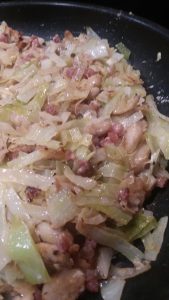 cannellini beans and cabbage with pancetta and parmesan, which two people made; for one it was “pretty good;” but for another it was a keeper, “love this combination– I could eat a lot of it.” Curried carrot salad was also a hit and a miss; one person didn’t like the curry with carrots, though the other did and enjoyed how the curry played with the sweetness of the carrots and raisins. Both noted that the amount of curry called for seemed excessive: one tablespoon for a pound of carrots. This was a bit overpowering in a dish where it was the main flavor, with no cooking to mellow it.
cannellini beans and cabbage with pancetta and parmesan, which two people made; for one it was “pretty good;” but for another it was a keeper, “love this combination– I could eat a lot of it.” Curried carrot salad was also a hit and a miss; one person didn’t like the curry with carrots, though the other did and enjoyed how the curry played with the sweetness of the carrots and raisins. Both noted that the amount of curry called for seemed excessive: one tablespoon for a pound of carrots. This was a bit overpowering in a dish where it was the main flavor, with no cooking to mellow it. 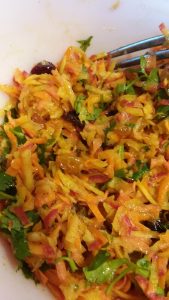
Overall, we liked this take on quick and easy. We enjoyed most of the flavor profiles, and we live in a large metro area where less-common ingredients are easy to come by. We liked that many ingredients also included an alternative, so you could use what you had on hand and/or could find at the supermarket. We did note some negatives: some recipes used a lot of salt (for instance, the hoisin squash recipe called for one tablespoon) or overpowering amounts of spices (see carrot salad above). In order to keep to the 30-minute time frame, oven heats were frequently listed at 475 or 500 degrees, which meant keeping a bit of an eye on things to prevent scorching or setting off the smoke detector! Many recipes didn’t list stovetop burner heat at all, which, while perhaps not strictly necessary, is helpful when you’re doing something for the first (or even second or third) time. Similarly, cooking times were often not listed. Guess Mr. Kimball is making sure we’re paying attention while cooking! And speaking of cooking, what’s the difference between “cook” and “cook-ish”? The subtitle of this book is “throw it together,” but it could be argued that all cooking is throwing it together in some way. Yes, these recipes are fairly simple– but you are definitely cooking. That’s my soapbox moment for this month!
The book itself was a pleasure to use– there were truly lovely, artistic photos of most recipes, and since those recipes were short and sweet, almost all fit on one page. Bonus! We also enjoyed how some recipes were grouped by cooking method, like stir-fry or the aforementioned one-pot pasta. This made it easy to try a new or different technique on multiple dishes. And if you like Milk Street’s concept, there are several other cookbooks to peruse, as well as the TV show and an extensive website. In the end, our ratings averaged out to around 3.5 (out of a possible 5), a better than average score for our group.
We’ll next meet on Friday, December 10 at 11 AM. Plan to chat via zoom; we will meet outdoors in person if the weather is unusually warm(!) We’re baking this month with local favorite Joanne Chang’s latest, Pastry Love (I highly recommend the chocolate-rye cookies!). Copies are available at the main circulation desk or via curbside pickup.
Happy Thanksgiving to all, and see you on the 10th.
**And special thanks to LC for the post title!
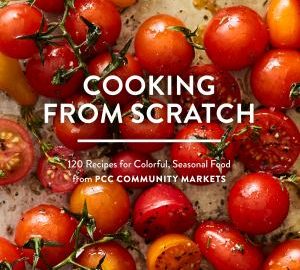
Bibliobites in September: Fresh But Not Fussy
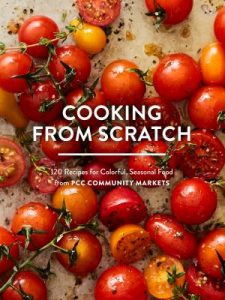 September brings that change of season with which we are all so happily familiar– cooler temps and shorter days, and the last glorious gasp of summer warmth. And September means that our Bibliobites group restarts after a summer off. We had envisioned meeting outdoors on a lovely late-summer morning, but alas– the weather did not cooperate and we met on a rather drippy morning via zoom. But despite the gray day, this month’s title seemed well-suited to this time of year when markets overflow with the bounty of summer and fall– tomatoes and apples; sweet corn and winter squashes; late peaches and the final round of green beans. This month’s title, Cooking From Scratch, is published by the cooks at PCC Markets in Seattle, the oldest and largest food co-op in the nation. This soup-to-nuts title surveys it all, with plenty of mealtime choices for both vegetarians and carnivores, as well as desserts, snacks, and beverages.
September brings that change of season with which we are all so happily familiar– cooler temps and shorter days, and the last glorious gasp of summer warmth. And September means that our Bibliobites group restarts after a summer off. We had envisioned meeting outdoors on a lovely late-summer morning, but alas– the weather did not cooperate and we met on a rather drippy morning via zoom. But despite the gray day, this month’s title seemed well-suited to this time of year when markets overflow with the bounty of summer and fall– tomatoes and apples; sweet corn and winter squashes; late peaches and the final round of green beans. This month’s title, Cooking From Scratch, is published by the cooks at PCC Markets in Seattle, the oldest and largest food co-op in the nation. This soup-to-nuts title surveys it all, with plenty of mealtime choices for both vegetarians and carnivores, as well as desserts, snacks, and beverages.
One big plus of this book was its beautiful full-page photographs which showed off the finished dishes to their best advantage. In some cookbooks the food winds up looking a bit artificial, but this title’s pictures made you want to pick up a fork and dive in! The book is the standard large format; it’s a paperback printed on heavy matte paper. There were no comments about the book staying open to one’s chosen page; my copy was newish and thus the binding was very tight and did not stay open. However with time and use that problem would dissipate. Many recipes fit on one page and the type was easy to read.
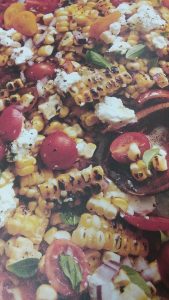 So, a good start– but once in the kitchen, how did things shake out? Summer food was still in the driver’s seat for some of us; for instance: grilled corn salad with goat cheese was a delicious version of a classic combination. The roasted corn was a nice way to change up an easily-made salad; “I would make it again in a heartbeat.” Corn was also the main event in
So, a good start– but once in the kitchen, how did things shake out? Summer food was still in the driver’s seat for some of us; for instance: grilled corn salad with goat cheese was a delicious version of a classic combination. The roasted corn was a nice way to change up an easily-made salad; “I would make it again in a heartbeat.” Corn was also the main event in 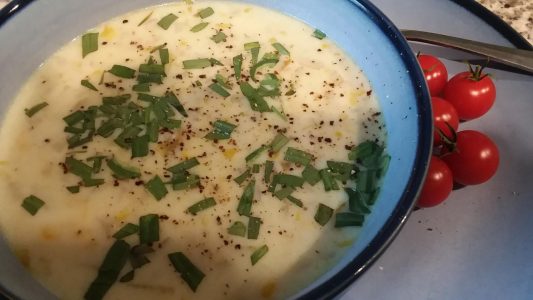 tarragon corn chowder. The tarragon was “a nice twist” that we loved. We noted that this recipe had what we considered to be the somewhat odd instruction to boil the potatoes with the milk- perhaps this is a west coast convention? In any event, those of us who made the soup ignored the directions and added the milk at the end, as all good New Englanders should! Staying with summer, summertime fritters were a solid version of this now-common way to use prolific zucchini. They were “straightforward” and “turned out well.” The roasted cherry tomatoes featured on the book’s cover delivered on flavor; they were “super-easy” and very good. And mango avocado fresh rolls looked pretty and tasted even better, with plenty of fresh fruity flavor and brightness from fresh basil and mint.
tarragon corn chowder. The tarragon was “a nice twist” that we loved. We noted that this recipe had what we considered to be the somewhat odd instruction to boil the potatoes with the milk- perhaps this is a west coast convention? In any event, those of us who made the soup ignored the directions and added the milk at the end, as all good New Englanders should! Staying with summer, summertime fritters were a solid version of this now-common way to use prolific zucchini. They were “straightforward” and “turned out well.” The roasted cherry tomatoes featured on the book’s cover delivered on flavor; they were “super-easy” and very good. And mango avocado fresh rolls looked pretty and tasted even better, with plenty of fresh fruity flavor and brightness from fresh basil and mint.
Moving into fall a bit, broccoli, lemon, and parmesan soup was “easy– delightful.” It used ingredients you’d be likely to have on hand, and was thickened only with vegetables, nice for those who can’t or don’t do dairy. Another fall favorite soup, butternut squash-apple soup, was a keeper! The coconut milk in it made the soup “velvety.” An easy and super version of this classic. Apple, bok choy, and carrot slaw was another “really good” and “colorful” salad that combined basic ingredients in a slightly different way. Kale and quinoa salad also upped the flavor profile of its fairly standard ingredients with tahini. Our cook misread the ingredient list and used tamari instead– and it was delicious that way, too! 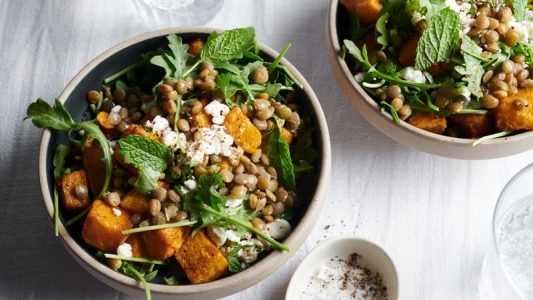 Spiced squash salad was “restaurant-worthy” with its caramelized squash atop tender arugula– simple yet sophisticated.
Spiced squash salad was “restaurant-worthy” with its caramelized squash atop tender arugula– simple yet sophisticated.
As always there were plenty of main dishes on our radar. Three people made garlicky green beans and shrimp; all enjoyed this easy-to-make combination, though for one person it could have had more garlic. A couple of people tried the tiger mountain turkey chili; it had good flavor though one person thought it was too spicy, while another thought it “needed more heat!” Most of us already have a preferred chili recipe, and this one didn’t convert anyone. Spicy pork and sweet potato stew was enjoyable, though it needed a bit more liquid; conversely, chilaquiles were “a bit soupy” though tasty! Thai steak salad was another keeper with its garlicky, “just yummy” marinade and dressing. It benefited from using a more tender cut of beef than the top round called for in the recipe. A couple of chicken recipes also earned high marks: spicy chicken thighs had a delicious rub, though “you have to like curry.” 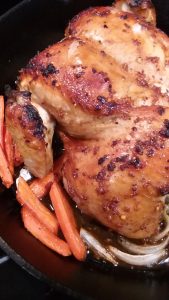 Pomegranate molasses grilled chicken was a terrific use for this newly-available ingredient. It was “a winner– so moist and tangy.”
Pomegranate molasses grilled chicken was a terrific use for this newly-available ingredient. It was “a winner– so moist and tangy.”
Seared scallops with arugula pesto was another restaurant-worthy, yet simple main dish; but linguine with asparagus and peas, though delicious, “needed something”– perhaps more salt? Steph’s tofu had good flavor, but was downgraded because it was “too much work,” and “the sauce burned.” If we lived near a PCC Market we could just go buy it there! Lentil and white bean stew was a bit heavy on the black pepper, but this classic combination was still a good choice. And curried lentil and mango wraps were a less-familiar, though delightful, combination. Red lentils meant they were quick to make, too.
There aren’t lots of desserts in this book, but we did try a few. Two people made flourless chocolate crinkles,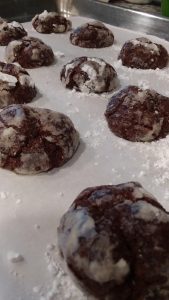 which had a nice tender texture from almond flour and rich deep chocolate flavor. However they didn’t flatten and crack on the tops the way they were supposed to. Luckily they were tasty enough that this wasn’t really a problem! Avocado brownies had an “odd fudgy texture” that just didn’t do it for our cook, though the chocolate flavor was excellent. Two of us were intrigued by rosemary thyme crackers though neither tried them. Had we met in person they would have undoubtedly appeared at our meeting, along with those brownies!
which had a nice tender texture from almond flour and rich deep chocolate flavor. However they didn’t flatten and crack on the tops the way they were supposed to. Luckily they were tasty enough that this wasn’t really a problem! Avocado brownies had an “odd fudgy texture” that just didn’t do it for our cook, though the chocolate flavor was excellent. Two of us were intrigued by rosemary thyme crackers though neither tried them. Had we met in person they would have undoubtedly appeared at our meeting, along with those brownies!
While there was nothing earth-shattering or wildly innovative about this book, most of us found it very appealing. The dressings and seasonings in particular really hit the mark, and we liked the various simple twists on classic recipes. Most recipes were uncomplicated, and many featured ingredients we were likely to have on hand. And the ultimate compliment: at least three people planned to buy the book. FYI, if your library’s copy of this book is checked out, and/or you don’t want to buy it, PCC’s website has most of the book’s recipes on its website, http://pccmarkets.com/healthy-eating/recipes. Our overall rating reflected our enjoyment of this title; it garnered a 4.14 out of a possible 5.
We’ll next meet on Friday, October 29 at 11 AM; once again we’ll try for outdoors in person if the weather is good. This month we’ll be cooking from Cookish by Christopher Kimball and the cooks at Milk Street. The watchwords for this title might be “simple” and “flavorful”– give it a try and see what you think! Copies are available at the main circulation desk or via curbside pickup.
**thanks to MM for the title of this post!
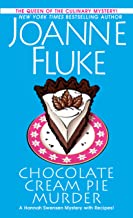
Bibliobites in June: In the Cookie Jar
 In June our Bibliobites group made a detour into the winter wonderland of Lake Eden, Minnesota, the fictional home of baker/amateur sleuth Hannah Swensen. Hannah has starred in multitudinous “cozy mysteries” which feature lots of discussions about food and baking, in addition to murder! This month’s title (26th in the series by author Joanne Fluke), The Chocolate Cream Pie Murder, includes over 30 recipes– so whether you wanted to solve a mystery, bake, or both, you had plenty of options. Our Midwestern sojourn may have been brief, but did we enjoy the ride? Or at least find some good cookie recipes?
In June our Bibliobites group made a detour into the winter wonderland of Lake Eden, Minnesota, the fictional home of baker/amateur sleuth Hannah Swensen. Hannah has starred in multitudinous “cozy mysteries” which feature lots of discussions about food and baking, in addition to murder! This month’s title (26th in the series by author Joanne Fluke), The Chocolate Cream Pie Murder, includes over 30 recipes– so whether you wanted to solve a mystery, bake, or both, you had plenty of options. Our Midwestern sojourn may have been brief, but did we enjoy the ride? Or at least find some good cookie recipes?
As we began our meeting, everyone confessed that they had not made any recipes from the book. This actually turned out to be a bit inaccurate (more on that later), but the main issue was that the weather was hot enough that most of us didn’t feel the urge to turn on the oven and bake. It didn’t help that the book takes place in February, and therefore most of the recipes were oriented accordingly– rich cakes, hearty breakfast bakes, stews, and soups. Not what most of us wanted to eat during a warm and sunny month! And there were complaints that many recipes used packaged ingredients– cake mixes, whipped topping, pudding mix, condensed soups– which most of us prefer to avoid. This reliance on mixes made for an old-fashioned feel, “very retro” as one person commented, despite the fact that this title was published in 2019.
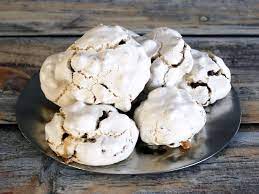 We did bake a few things (despite the initial denials); peach scones were “not very peachy” despite containing a goodly amount of peach jam, and the consistency of the scones seemed a bit off– they were more like a cakey cookie than a flaky scone. But, “they were good with jam.” Another breakfast treat, apricot coffee cake, was “solid” but not outstanding. It was a pretty standard combination of cake, fruit filling, and crumbly topping. Forgotten cookies were fun to make and tasty; this classic recipe is a meringue combined with chocolate chips and nuts. Once the cookie batter is dropped onto a baking sheet, you put them in the oven and then immediately turn the oven off; the cookies stay in the oven overnight, and in the morning they’re ready to go. Just be sure you don’t make them on a humid/rainy day! The recipes had some quirks; for instance, we noticed that the author constantly tells you to pack the flour into the cup when measuring, which none of us had ever seen before. Some of her instructions seemed overly detailed and verbose (“take out a spoon from your silverware drawer”), but that could be helpful for an inexperienced cook.
We did bake a few things (despite the initial denials); peach scones were “not very peachy” despite containing a goodly amount of peach jam, and the consistency of the scones seemed a bit off– they were more like a cakey cookie than a flaky scone. But, “they were good with jam.” Another breakfast treat, apricot coffee cake, was “solid” but not outstanding. It was a pretty standard combination of cake, fruit filling, and crumbly topping. Forgotten cookies were fun to make and tasty; this classic recipe is a meringue combined with chocolate chips and nuts. Once the cookie batter is dropped onto a baking sheet, you put them in the oven and then immediately turn the oven off; the cookies stay in the oven overnight, and in the morning they’re ready to go. Just be sure you don’t make them on a humid/rainy day! The recipes had some quirks; for instance, we noticed that the author constantly tells you to pack the flour into the cup when measuring, which none of us had ever seen before. Some of her instructions seemed overly detailed and verbose (“take out a spoon from your silverware drawer”), but that could be helpful for an inexperienced cook.
 For the murder mystery, there were widely varying opinions. Some thought this title, and her others, were the perfect beach read. They’re “fun….light….not gruesome.” They’re an “escape” and “you can read them in a couple of hours.” Others were disappointed, “it wasn’t a book for me,” “I gave up after a few chapters,” “the book dropped me into the middle of the story– there were no explanations about the characters (needed if you hadn’t read the whole series).” The writing didn’t make the grade for some, “I thought it was very poorly written,” and overall it “felt a little dated.” But, clearly the author has found a formula that works for her legions of faithful fans– so her success is not a fluke (pun intended!). The Hannah Swensen stories have also been turned into a Hallmark Channel series called Murder She Baked, so if you like the books you’ll probably enjoy the movies.
For the murder mystery, there were widely varying opinions. Some thought this title, and her others, were the perfect beach read. They’re “fun….light….not gruesome.” They’re an “escape” and “you can read them in a couple of hours.” Others were disappointed, “it wasn’t a book for me,” “I gave up after a few chapters,” “the book dropped me into the middle of the story– there were no explanations about the characters (needed if you hadn’t read the whole series).” The writing didn’t make the grade for some, “I thought it was very poorly written,” and overall it “felt a little dated.” But, clearly the author has found a formula that works for her legions of faithful fans– so her success is not a fluke (pun intended!). The Hannah Swensen stories have also been turned into a Hallmark Channel series called Murder She Baked, so if you like the books you’ll probably enjoy the movies.
Since this title has two distinct components (a mystery and recipes), we rated them separately; the story averaged out to a 2.6 (out of a possible 5), and the recipes were uniformly rated a 2. So, though some of us will be happy to revisit Lake Eden and its denizens, we probably won’t be baking much from these books!
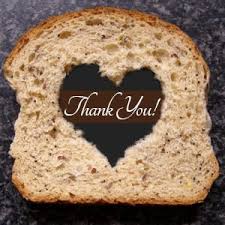 Our June meeting was the last until September; we’ll next meet on Friday, September 24 at 11 AM; and by then we hope we will be able to meet in person in the library. Thank you so much to everyone who participated this year, either on zoom, or via email, or by stopping into the library to briefly chat. Your enthusiasm and good humor during the past year and a half are greatly appreciated, and won’t be soon forgotten.
Our June meeting was the last until September; we’ll next meet on Friday, September 24 at 11 AM; and by then we hope we will be able to meet in person in the library. Thank you so much to everyone who participated this year, either on zoom, or via email, or by stopping into the library to briefly chat. Your enthusiasm and good humor during the past year and a half are greatly appreciated, and won’t be soon forgotten.
Have a wonderful summer, and see you in the fall!
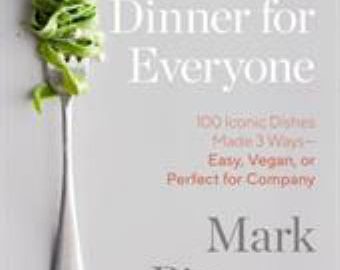
Bibliobites in May: Dinner: The Neverending Story
 Every day, the dinner decision looms: Chicken or pasta? Takeout or home-cooked? Thirty minutes or two hours? Most of us are fortunate enough to have the luxury of dithering over what we feel like eating on any given night, and how much time and effort we want to devote to our evening meal. And cookbook authors, it seems, are more than willing to keep revisiting this engrossing subject. You’d think by now that all possible avenues would have been explored, but just in the last year alone, our Bibliobites group has cooked their way through six recent titles devoted wholly or primarily to dinner. And continuing in that vein, this month we kitchen-tested Mark Bittman’s most recent title, Dinner For Everyone, a bold claim if ever there was one. However, since Mr. Bittman is the one who taught us how to cook everything, dinner for everyone seems like a natural progression!
Every day, the dinner decision looms: Chicken or pasta? Takeout or home-cooked? Thirty minutes or two hours? Most of us are fortunate enough to have the luxury of dithering over what we feel like eating on any given night, and how much time and effort we want to devote to our evening meal. And cookbook authors, it seems, are more than willing to keep revisiting this engrossing subject. You’d think by now that all possible avenues would have been explored, but just in the last year alone, our Bibliobites group has cooked their way through six recent titles devoted wholly or primarily to dinner. And continuing in that vein, this month we kitchen-tested Mark Bittman’s most recent title, Dinner For Everyone, a bold claim if ever there was one. However, since Mr. Bittman is the one who taught us how to cook everything, dinner for everyone seems like a natural progression!
 This book is organized in a unique way: recipes are presented in sets of three, which detail three ways of producing a meal, either quick and easy; vegan; or company-worthy (essentially, a project for when you have time). Each set of recipes represents a theme; a similarity of taste or ingredients or method. This could be helpful if you knew you wanted to use a particular ingredient, or if you had a hankering for, say, Asian flavors. But some in the group thought this arrangement was “contrived,” and others thought it was “fun to look at…but not so practical.” Most of us aren’t yet inviting groups of people to our homes, so there wasn’t much testing of the “company” recipes; but we did appreciate that this title gave us lots of diverse choices. One notably irritating aspect of the book was that for each set of three recipes, there was only one photo, and most of the time the photo wasn’t of the recipe that was printed next to it. This caused a fair amount of confusion, as we wondered why photo and nearby text didn’t match. Needless to say, we wished for more (and logically placed) photos!
This book is organized in a unique way: recipes are presented in sets of three, which detail three ways of producing a meal, either quick and easy; vegan; or company-worthy (essentially, a project for when you have time). Each set of recipes represents a theme; a similarity of taste or ingredients or method. This could be helpful if you knew you wanted to use a particular ingredient, or if you had a hankering for, say, Asian flavors. But some in the group thought this arrangement was “contrived,” and others thought it was “fun to look at…but not so practical.” Most of us aren’t yet inviting groups of people to our homes, so there wasn’t much testing of the “company” recipes; but we did appreciate that this title gave us lots of diverse choices. One notably irritating aspect of the book was that for each set of three recipes, there was only one photo, and most of the time the photo wasn’t of the recipe that was printed next to it. This caused a fair amount of confusion, as we wondered why photo and nearby text didn’t match. Needless to say, we wished for more (and logically placed) photos!
Most of us focused on the “easy” category (hey, we just want to use our time efficiently!), where we found some keepers– and a few duds. Udon with ginger-roasted carrots and miso sauce was a definite keeper, with its deeply flavored, savory sauce. Caramel salmon also had a fabulous sauce, though this traditional Vietnamese combination was “too sweet” for one person. A “really good” peanut sauce was featured in  pork tenderloin simmered in peanut sauce; as is true of almost any peanut sauce, it was delicious on just about anything and played quite nicely with chicken or vegetables. Sausage and escarole used this slightly bitter green in a new way: it was roasted and topped with Parmesan cheese, which was enjoyably different. Falafel hash was another keeper; this simple combination really delivered in the flavor department, with just enough spice and a lemony sauce. It would be excellent for brunch with an egg fried on top, but was just fine all by itself. Spicy tuna rice bowl was a quick and tasty bowl made with basic pantry ingredients, but it suffered mightily in the looks department: the tuna and its soy-laced sauce created an unappealing lumpy brown puddle atop the rice, reminiscent of– well, perhaps better not to say!
pork tenderloin simmered in peanut sauce; as is true of almost any peanut sauce, it was delicious on just about anything and played quite nicely with chicken or vegetables. Sausage and escarole used this slightly bitter green in a new way: it was roasted and topped with Parmesan cheese, which was enjoyably different. Falafel hash was another keeper; this simple combination really delivered in the flavor department, with just enough spice and a lemony sauce. It would be excellent for brunch with an egg fried on top, but was just fine all by itself. Spicy tuna rice bowl was a quick and tasty bowl made with basic pantry ingredients, but it suffered mightily in the looks department: the tuna and its soy-laced sauce created an unappealing lumpy brown puddle atop the rice, reminiscent of– well, perhaps better not to say!
There were a few misses in this “easy” category; for instance, shrimp melts were “kind of blah,” plus the mixture was hard to work with and didn’t want to stick together. However, when at last the cakes were formed, they did stick to the pan! Orzo with shrimp and dill had way too much pasta for the amount of shrimp (a problem also encountered with orecchiette with salmon), and both dishes were a bit too basic. Shrimp with olives suffered from some timing issues, but it was fast and easy, though a bit too salty. Sausage gumbo was “good…easy…but I have other gumbo recipes that are better;” and couscous and chicken with tunisian spices, despite a nice variety of spices, somehow “didn’t have a lot of flavor.” One-pot stroganoff was a hit and a miss: one person thought it was “bland” and needed something to add depth; but another person enjoyed it and pronounced it a keeper.
and both dishes were a bit too basic. Shrimp with olives suffered from some timing issues, but it was fast and easy, though a bit too salty. Sausage gumbo was “good…easy…but I have other gumbo recipes that are better;” and couscous and chicken with tunisian spices, despite a nice variety of spices, somehow “didn’t have a lot of flavor.” One-pot stroganoff was a hit and a miss: one person thought it was “bland” and needed something to add depth; but another person enjoyed it and pronounced it a keeper.
Moving on to more challenging categories, those who tried anything in the “vegan” group unanimously thought the recipes were complicated– as in, time-consuming and with a lot of prep. We did attempt a few; creamy white bean pasta and cauliflower was a vegan version of that all-time fave, macaroni and cheese. This one was “pretty easy” and did deliver on its promise of creamy, saucy pasta and crisp breadcrumb topper.  Mushroom-sweet potato moussaka was “a lot of work” with its many steps. But it did make a big batch, and was “good….different,” though it called for too much cinnamon (2 teaspoons!). However, it was worth trying again. Teriyaki mushrooms also had lots of steps, but were “really delicious” with a yummy sauce. And sweet potato and corn enchiladas were also a bit of a project (as enchiladas often are); overall, this dish was a winner, though the filling didn’t hold together well and “needed something.” The sauce was excellent, though– in fact, most if not all of the author’s sauces were extremely well-liked.
Mushroom-sweet potato moussaka was “a lot of work” with its many steps. But it did make a big batch, and was “good….different,” though it called for too much cinnamon (2 teaspoons!). However, it was worth trying again. Teriyaki mushrooms also had lots of steps, but were “really delicious” with a yummy sauce. And sweet potato and corn enchiladas were also a bit of a project (as enchiladas often are); overall, this dish was a winner, though the filling didn’t hold together well and “needed something.” The sauce was excellent, though– in fact, most if not all of the author’s sauces were extremely well-liked.
One or two “company” recipes rounded out our adventures: orange beef was a super version of this classic, with a mellow, yet bracing, orange flavor. Though it’s classed as a “project” recipe, it was fairly simple, and had the advantage of still tasting delicious after a few days in the fridge. And baked mascarpone french toast was a keeper; this lush, custardy casserole was perfectly accented by sweet/tart fruit. Bonus: you put it together the night before.
was a keeper; this lush, custardy casserole was perfectly accented by sweet/tart fruit. Bonus: you put it together the night before.
As a group, we were unequivocally equivocal about this title! Most of us are Bittman fans, and several own his books (the most popular being How to Cook Everything). But this one didn’t seem to measure up to some of his others, despite admittedly producing a decent number of keepers. One person was thinking about buying the book– she liked the range of choices and many of the flavor profiles appealed to her. For the rest of us, it was a bit of a “meh,” reflected in our voting, which averaged out to just over a 3 (out of a possible 5). As a point of comparison, the author’s VB6 book (January 2018) garnered a 2, while How to Cook Everything Fast (May 2017) snagged an overall 3.25. So, we mostly like him– but we’re not completely sold!
We’ll next meet on Friday, June 25 at 11 AM. If the weather is favorable, we will meet in person outdoors!! If it’s rainy or super hot, we will revert to Zoom. This month we’re mixing in some fiction with our food with Joanne Fluke’s The Chocolate Cream Pie Murder. Copies are available at the main desk. If you would like to attend the meeting, and are not already on our mailing list, please email group leader Andrea Grant. See you then!





